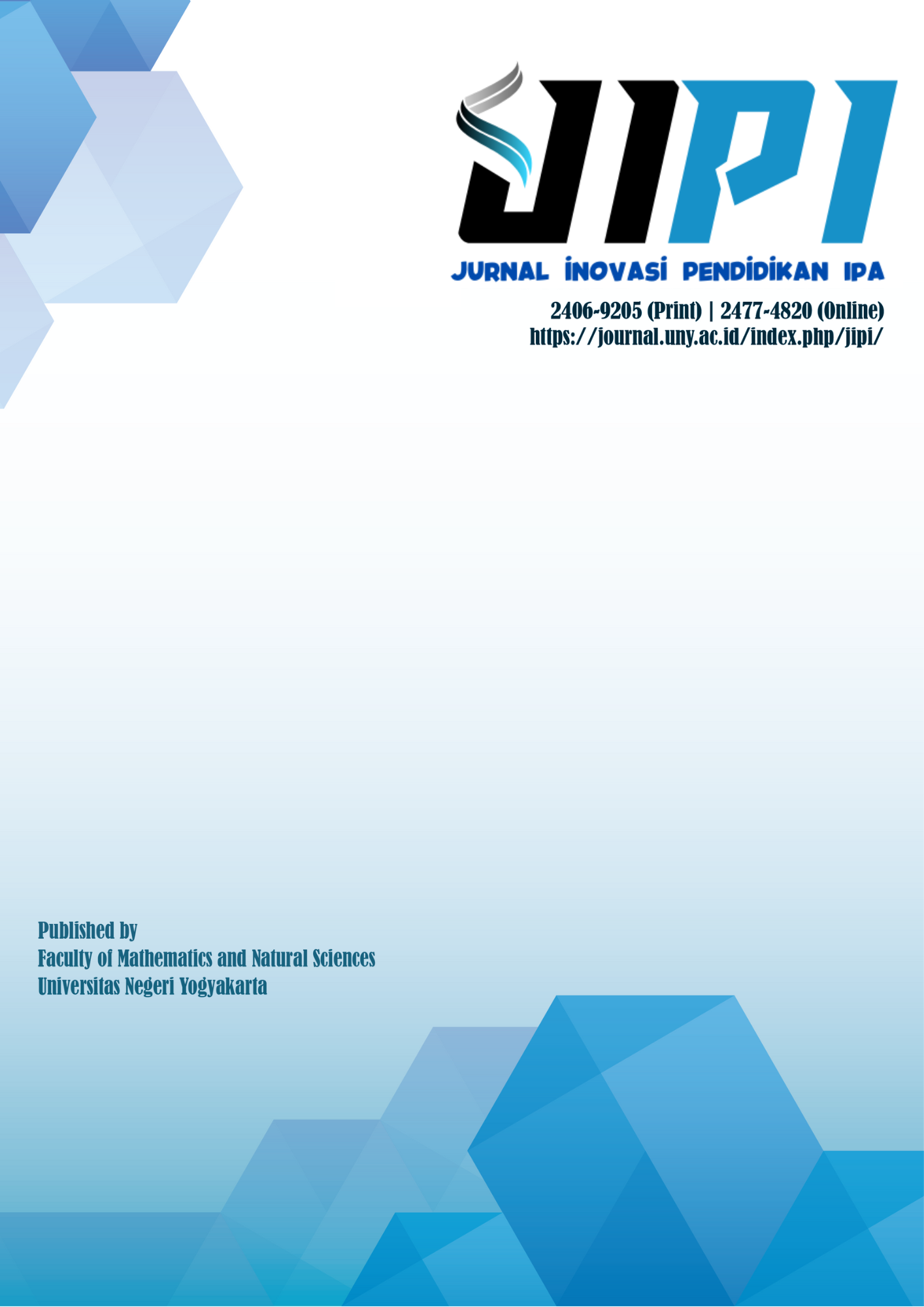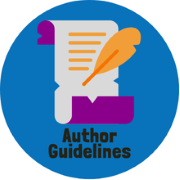The Effectiveness of the PhET-Assisted Creative Problem Solving Model on Students' Creative Thinking Abilities and Cognitive Learning Outcomes
DOI:
https://doi.org/10.21831/jipi.v9i2.45902Keywords:
model creative problem solving, PhET, kemampuan berpikir kreatif, hasil belajar kognitifAbstract
This research aims to determine the effectiveness of the PhET-assisted creative problem solving model on creative thinking abilities and student learning outcomes in vibration, wave and sound materials. In this research, the samples taken were determined based on the characteristics of the two classes which were almost the same (homogeneous). The characteristics used are the average UAS scores of two classes which are close to the same and the science teacher who teaches in the same class. The sample chosen was class VIII with class A as the control class and class B as the experimental class with a total of 16 students in each class. This research uses an experimental method with a nonequivalent control group design. Data on students' cognitive learning outcomes were taken using a test method in the form of 15 multiple choice questions, while students' creative thinking abilities used a test method in the form of 5 descriptive questions which had been tested for validity and reliability with a significance level of 5%, resulting in rcount > rtable. Research data was obtained from pretest-posttest scores and analyzed using the MANCOVA statistical test. The results of the multivariate analysis show that the sig value is <0.05, namely 0.001 <0.005, which means that there is a significant influence. The N-gain results show an increase in creative thinking abilities by 56.57% and an increase in students' cognitive learning outcomes by 57.08% which is included in the medium category. Therefore, it can be concluded that the use of the creative problem solving model assisted by PhET significantly increases students' creative thinking abilities compared to conventional learning. In addition, there is a significant increase in the cognitive learning outcomes of students who use this model. The implementation of PhET as an interactive learning tool opens up opportunities for students to understand science concepts in a more in-depth and contextual way. Implications of these findings include increased student engagement, development of innovative learning models, and emphasis on problem-based learning. This research contributes to educational practitioners and researchers in understanding the potential of the PhET-assisted creative problem solving model as a practical approach to improving students' learning outcomes and creative thinking abilities in the context of science learning.
References
Antika, R. N., & Nawawi, S. (2017). Pengaruh Model Project Based Learning Pada Mata Kuliah Seminar Terhadap Keterampilan Berpikir Kreatif Mahasiswa. Jurnal Pendidikan Biologi Indonesia, 3(1), 72–79.
Fikri, A. A., Ismah, V., & Paidi, P. (2018). Pengembangan Perangkat Pembelajaran Model Guided Inquiry untuk Meningkatkan Creative Thinking Siswa. Thabiea: Journal of Natural Science Teaching, 1(1), 1–8.
Fuadi, H., Robbia, A. Z., Jamaluddin, J., & Jufri, A. W. (2020). Analisis Faktor Penyebab Rendahnya Kemampuan Literasi Sains Peserta Didik. Jurnal Ilmiah Profesi Pendidikan, 5(2), 108–116.
Ghasemi, F., Rastegar, A., Jahromi, R. G., & Marvdashti, R. R. (2011). The relationship between creativity and achievement motivation with high school students' entrepreneurship. Procedia-Social and Behavioral Sciences, 30, 1291–1296.
Gonzales, J., Escobar, J., Sanchez, H., De La Hoz, J., & Beltran, J. (2017). 2D and 3D virtual interactive laboratories of physics on Unity platform. Journal of Physics: Conference Series, 935(1), 12–69.
Haqiqi, A. ., & Sa'adah, L. (2018). Deskripsi Kesulitan Belajar Materi Fisika pada Siswa Sekolah Menengah Pertama (SMP) Di Kota Semarang. Thabiea: Journal of Natural Science Teaching, 1(1), 39–43.
Hermansyah, H., Gunawan, G., & Herayanti, L. (2015). Pengaruh Penggunaan Laboratorium Virtual Terhadap Penguasaan Konsep Dan Kemampuan Berpikir Kreatif Siswa Pada Materi Getaran Dan Gelombang. Jurnal Pendidikan Fisika Dan Teknologi, 1(2), 97–102.
Kasmaienezhadfard, S., Talebo, B., Roustaee, R., & Pourrajab, M. (2015). Student's Learning Through Teaching Creativity: Teacher's Percepcion. Journal of Education, Health and Community Psychology, 4(1), 1–13.
Kurniawan, R. A., Rifa'i, M. R., & Fajar, D. M. (2020). Analisis Kemenarikan Media Pembelajaran PhET Berbasis Virtual Lab Pada Materi Listrik Statis Selama Perkuliahan Daring Ditinjau Dari Perspektif Mahasiswa. VEKTOR: Jurnal Pendidikan IPA, 1(1), 19–28.
Mahmudah, L. (2019). Peningkatan Soft Skill Kerja Sama dan Pemahaman Konsep Peserta Didik Kelas VIII MTs Ma'arif NU 1 Patikraja pada Mata Pelajaran IPA Melalui Penerapan Model Pembelajaran Problem Based Learning. Thabiea: Journal of Natural Science Teaching, 2(1), 39–44.
Malahayati, E. N. (2017). Pengaruh Lembar Kerja Siswa (LKS) Berbasis Creative Problem Solving (CPS) Pada Materi Keanekaragaman Hayati Untuk Meningkatkan Kemampuan Berpikir Kritis Dan Hasil Belajar Siswa Kelas X SMAN 4 Blitar. Konstruktivisme: Jurnal Pendidikan Dan Pembelajaran, 9(2), 147–158.
Malisa, S., Bakti, I., & Iriani, R. (2018). Model Pembelajaran Creative Problem Solving (CPS) Untuk Meningkatkan Hasil Belajar Dan Kemampuan Berpikir Kreatif Siswa. Vidya Karya, 33(1), 1–20.
Marisyah, M., Zainuddin, Z., & Hartini, S. (2016). Meningkatkan Keterampilan Proses Sains dan Hasil Belajar Siswa Pada Pelajaran IPA Fisika Kelas VIII B SMPN 24 Banjarmasin Melalui Model Inkuiri Terbimbing. Berkala Ilmiah Pendidikan Fisika, 4(1), 52–63.
Maryam, E. (2019). Pengaruh Laboratorium Virtual Terhadap Prestasi Fisika Pada Pokok Bahasan Listrik Statis. Jurnal Ilmu Pendidikan Dan Kependidikan, 33(1), 1–20.
Munandar, U. (2017). Mengembangkan Bakat dan Kreativitas Anak Sekolah. Jakarta: PT. Gramedia.
Muzana, S. R., & Astuti, D. (2017). Penerapan Pembelajaran Berbasis Simulasi PhET untuk Meningkatkan Pemahaman Konsep Fisika Inti pada Siswa SMA. Prosiding SEMDI-UNAYA (Seminar Nasional Multi Disiplin Ilmu UNAYA), 409–417.
Nugraha, A. J., Suyitno, H., & Susilaningsih, E. (2017). Analisis kemampuan berpikir kritis ditinjau dari keterampilan proses sains dan motivasi belajar melalui model PBL. Journal of Primary Education, 6(1), 35–43.
Paat, M., Kawuwung, F. R., & Mokalu, Y. B. (2021). Penerapan LKS Model Pembelajaran Berbasis Masalah Untuk Meningkatkan Kemampuan Berpikir Tingkat Tinggi SMPN 5 Tondano. JISIP (Jurnal Ilmu Sosial Dan Pendidikan), 5(2), 469–476.
Prasetyowati, R. (2014). Pembelajaran IPA SMP Menurut Kurikulum 2013.
Putri, C. S., Sesunan, F., & Wahyudi, I. (2019). Pengaruh Penerapan Model Pembelajaran Creative Problem Solving untuk Meningkatkan Kemampuan Berpikir Kreatif Dalam Pemecahan Masalah Fisika Pada Siswa SMA. Jurnal Pendidikan Fisika, 7(2), 149–155.
Sari, A. D., & Noer, S. H. (2017). Kemampuan Pemecahan Masalah Matematis dengan Model Creative Problem Solving (CPS) dalam Pembelajaran Matematika. Prosiding Seminar Nasional Matematika Dan Pendidikan Matematika, 245–252.
Satriaman, K. T., Pujani, N. M., & Sarini, P. (2019). Implementasi Pendekatan Student Centered Learning Dalam Penmbelajaran IPA Dan Relevansinya Dengan Hasil Belajar Siswa Kelas VIII SMP Negeri Singaraja. Jurnal Pendidikan Dan Pembelajaran Sains Indonesia (JPPSI), 1(1), 12–22.
Shoimin, A. (2016). 68 Model Pembelajaran Inovatif Dalam Kurikulum 2013. Yogyakarta: Ar-ruzz Media.
Sudjana. (2005). Metode Statistika. Bandung: Tarsito.
Wijaya, E. Y., Sudjimat, D. A., Nyoto, A., & Malang, U. (2016). Transformasi Pendidikan Abad 21 Sebagai Tuntutan Pengembangan Sumber Daya Manusia Di Era Global. Prosiding Seminar Nasional Pendidikan Matematika, 263–278.
Downloads
Published
How to Cite
Issue
Section
Citation Check
License
The authors submitting a manuscript to this journal agree that, if accepted for publication, copyright publishing of the submission shall be assigned to Jurnal Inovasi Pendidikan IPA (JIPI). However, even though the journal asks for a copyright transfer, the authors retain (or are granted back) significant scholarly rights.
Jurnal Inovasi Pendidikan IPA by http://journal.uny.ac.id/index.php/jipi/index is licensed under a Creative Commons Attribution-ShareAlike 4.0 International License.










